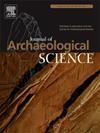A Cumulative Interaction Path Analysis for Santo Domingo Tonaltepec, Mixteca Alta, Mexico
IF 2.6
1区 地球科学
Q1 ANTHROPOLOGY
引用次数: 0
Abstract
We present a Cumulative Interaction Path Analysis (CIPA) that combines a Least Cost Path (LCP) analysis with a gravitational principle of political interaction to examine the development of a peripheral area in relation to a peer polity system and its changes through time. We performed this analysis on a large settlement pattern database of pre-Hispanic sites in the Mixteca Alta region of Mexico, centered on the modern-day pottery-making community of Santo Domingo Tonaltepec. The results of the analysis suggest that in early periods Tonaltepec was relatively isolated from the larger network and in later times it became an important node between polities. This change related not so much to Tonaltepec itself, but to changes in the relative importance of the polities that developed around it. This supports the idea that the locational advantages of a site are dependent on the broader interaction network and the political developments that occur at larger scales. Our methods and results are significant not only in understanding the historical trajectory of this corner of the world but also serves as a case study on how to approach broader processes in other world regions where large settlement-pattern databases exist.
墨西哥Mixteca Alta省Santo Domingo Tonaltepec的累积相互作用路径分析
我们提出了一种累积相互作用路径分析(CIPA),将最小成本路径(LCP)分析与政治相互作用的引力原理相结合,以研究与对等政体系统相关的外围地区的发展及其随时间的变化。我们对墨西哥Mixteca Alta地区前西班牙裔遗址的大型定居模式数据库进行了分析,该数据库以Santo Domingo Tonaltepec的现代陶器制作社区为中心。分析结果表明,在早期,Tonaltepec相对孤立于更大的网络,在后来的时代,它成为政治之间的重要节点。这种变化与Tonaltepec本身关系不大,而是与围绕它发展的政策相对重要性的变化有关。这支持了这样一种观点,即一个地点的区位优势取决于更广泛的互动网络和更大规模的政治发展。我们的方法和结果不仅在理解世界这一角落的历史轨迹方面具有重要意义,而且可以作为如何在存在大型定居模式数据库的世界其他地区处理更广泛过程的案例研究。
本文章由计算机程序翻译,如有差异,请以英文原文为准。
求助全文
约1分钟内获得全文
求助全文
来源期刊

Journal of Archaeological Science
地学-地球科学综合
CiteScore
6.10
自引率
7.10%
发文量
112
审稿时长
49 days
期刊介绍:
The Journal of Archaeological Science is aimed at archaeologists and scientists with particular interests in advancing the development and application of scientific techniques and methodologies to all areas of archaeology. This established monthly journal publishes focus articles, original research papers and major review articles, of wide archaeological significance. The journal provides an international forum for archaeologists and scientists from widely different scientific backgrounds who share a common interest in developing and applying scientific methods to inform major debates through improving the quality and reliability of scientific information derived from archaeological research.
 求助内容:
求助内容: 应助结果提醒方式:
应助结果提醒方式:


